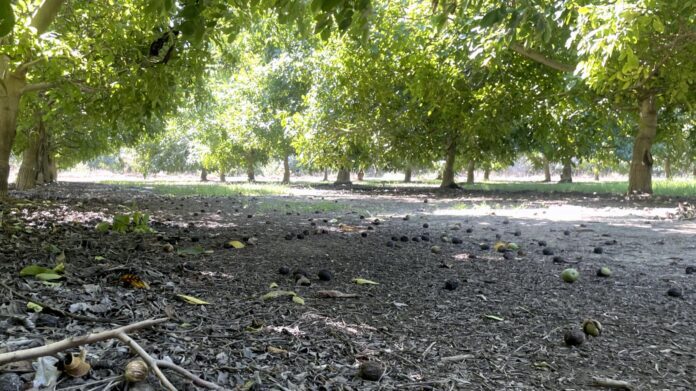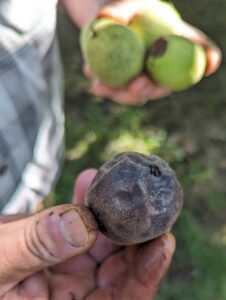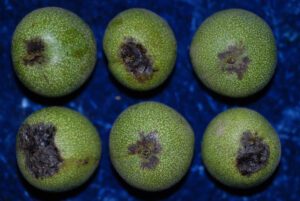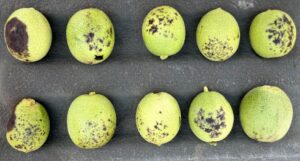
Walnut blight and brown apical necrosis (BAN) are perennial disease problems in some parts of the state, particularly in conducive microclimates in the Sacramento Valley.
But near-record rains, including unexpected midseason storms, and cost-cutting by many walnut growers in 2023 increased disease prevalence and associated yield and quality issues in parts of the state.
To help reduce walnut disease incidence in 2024, university experts recommend timely bactericide and fungicide applications, good spray coverage, rotating effective modes of action, disease monitoring and adjusting sprinklers to avoid leaf wetting.
“I think going into next season with the predictions of an El Niño weather year, growers who saw blight in their nuts in June should know the disease pressure is high, and they’ll be more inclined to spray,” said Clarissa Reyes, UCCE orchard systems advisor for Yuba and Sutter counties.
The bacterial infection blight can reduce yield as infected nuts drop prematurely. It also may open the nut up to mold infections. BAN, caused by a fungal complex, can lead to kernel mold and reduced nut quality and yield. Frequently, pathologists isolate both the blight bacterium (Xanthomonas juglandis) and mold organisms from infected walnuts.
“All of it depends on the weather,” said UC Davis Plant Pathology Professor Themis Michailides. “If the weather is wet, you’ll get the blight, which is the bacterial disease. Then later on, you get what we call BAN, which is brown apical necrosis.”
Reyes and other Sacramento Valley advisors began receiving calls about black nut drop about a month before the 2023 harvest. Callers also noted dark spots on the stylar end (the end opposite the stem) of walnut hulls and black lesions on the sides of the hulls. The advisors collected samples and sent them to Michailides to confirm their initial diagnoses of BAN for the stylar end lesions and blight for the side lesions.

Reyes and Michailides blamed several factors for the unusually high amount of the two diseases. “There was very low disease pressure in the two years that I’ve been around in 2021 and 2022, and people weren’t in the habit of spraying with the low prices,” Reyes said. “This [past] winter was pretty wet, and I don’t think that was too much of a surprise, but I think the summer rains were definitely not expected.”
She was referring to June storms as well as to remnants of Hurricane Hillary, which brought rains to parts of the Sacramento and San Joaquin valleys the latter part of August.
While BAN started developing beforehand, Michailides said the late-season precipitation increased the mold incidence and late-season blight. He said he saw similar occurrences in 2022 when late rains promoted severe mold problems.
Part of the challenge with blight and BAN management is growers must apply disease sprays ahead of rains to obtain the best results and help protect plant tissue. With continuing low walnut prices, Reyes said some growers are reluctant to gamble on storms that may break up before they reach the region.
Some growers also may have cut corners by spraying every other row, but good spray coverage is crucial to maximize the amount of bactericide or fungicide that reaches the target.

While Scott Drobny, a PCA for Nutrien Ag Solutions based in Hamilton City, Calif., definitely saw more blight and BAN in 2023, he said the more difficult part of the equation was grower finances.
“With the price of walnuts being so low and the price of inputs still being slightly inflated from COVID-19 and supply chain issues, farmers had a really tough time picking their poison, so to speak,” he said. “A lot of the time, they’d go after their No. 1 pest in each orchard. Maybe it’s disease in one orchard and weeds or insects in another. So, with the price of walnuts being so low and people struggling to make any money at the end of the year, consultants end up managing expectations.”
As such, he said he would have conversations with growers about potential economic damage and the amount they were willing to accept.
“Economics are a big part of farming and a big part of my job as a crop consultant,” he said. “We have economic thresholds and maybe we can tolerate a little bit of damage here and there.”

Nevertheless, Drobny said the mild 2023 growing season helped produce significantly better-quality walnuts overall than in 2022, when a late summer heat spell caused widespread kernel damage.
Walnut Blight
Walnut blight is caused by the Xanthomonas arboricola pv juglandis bacterium, which is present in nearly all orchards at some level, Michailides said. Symptoms appear on the sides of hulls as patchy dark spots with soft margins or as black lesions with hard margins.
The bacterium can infect any green walnut tissue, predisposing nuts to insect and disease damage and lower-quality nuts.
Like any disease, he said blight only develops if all three parts of the disease triangle are present: pathogen, environment and host. In the case of blight, it needs the X. arboricola pathogen; free moisture from rain, sprinklers or dew; and unprotected green tissue.
The blight pathogen overwinters in outer bud scales as well as twig canker infections. Inside the dormant bud, inner leaf tissue and flowers are pathogen free. As the shoots grow through the infected bud scales in the spring, rain or other water may splash or blow the bacteria onto developing green tissue.
Blight sprays, which coincide with early shoot emergence, provide a protective layer of bactericide on the tissue surface. Because not all walnut shoots emerge at the same time, Extension recommends the first blight spray be made when 20% to 40% of shoots are elongating and before leaves expand, commonly referred to as the “prayer” stage. Depending on the year, location and variety, this typically starts in April.
The second spray should be applied 7 to 10 days later to protect later-opening buds. Based on conditions, up to six applications may be needed to control blight.
UC Riverside Plant Pathology Professor Jim Adaskaveg conducts annual bactericide and fungicide screenings to determine efficacy, rates, timing and whether resistance is developing. His work has identified widespread copper resistance from overuse in the Sacramento Valley with scattered pockets in the San Joaquin Valley.
The EPA registered kasugamycin, marketed as Kasumin, in 2018 to help manage walnut blight as well as a handful of other bacterial diseases in other crops. It is a unique bactericide that is not used for animals or humans.
Based on Adaskaveg’s trials, copper, mancozeb and kasugamycin are the three most effective conventional bactericides for walnut blight. To prolong their usefulness, he recommended rotating effective modes of action and tank mixing the newly registered product with mancozeb or copper.
“Kasugamycin-mancozeb mixtures applied in our research trials were often the most effective of all treatments evaluated,” he wrote in the report. Kasumin has a relatively short residual, prompting the 7- to 10-day spray interval.
He recommended using copper-mancozeb last in the rotation since they provide the longest-lasting residuals of both active ingredients.
Results from the 2022 UC efficacy trials, the last year for which data is available, can be found at https://cfn-fungicides.ucr.edu/efficacy-tables/walnut.
Initially, blight bacteria are the primary source of inoculum, and typical hot, dry summer conditions significantly reduce additional infections.
But if conducive conditions continue, as they did in 2023 with June and August rains, secondary inoculum can lead to late-season blight and inoculum buildup in the orchard.
Brown Apical Necrosis or BAN
BAN symptoms begin as brown spots or marks at the stylar end of the walnut hull and may eventually grow and coalesce, ultimately infecting internal tissue. The disease is caused by a host of fungi that include Alternaria, Fusarium, Aspergillus niger, Botryosphaeria and Phomopsis.
Of those, work by Michailides’ lab found Alternaria, Fusarium and A. niger were predominately responsible for kernel mold. Michailides’ research also found secondary walnut blight infections that do not penetrate the kernel or result in nut drop can still create an entryway for pests, including Fusarium and Alternaria mold species.
In field trials, Michailides found applying Merivon (fluxapyroxad and pyraclostrobin) or Rhyme (flutriafol) fungicide two to three weeks before hull split followed by a second at early hull split significantly reduced kernel mold damage. The results proved true for both early and late walnut cultivars.










